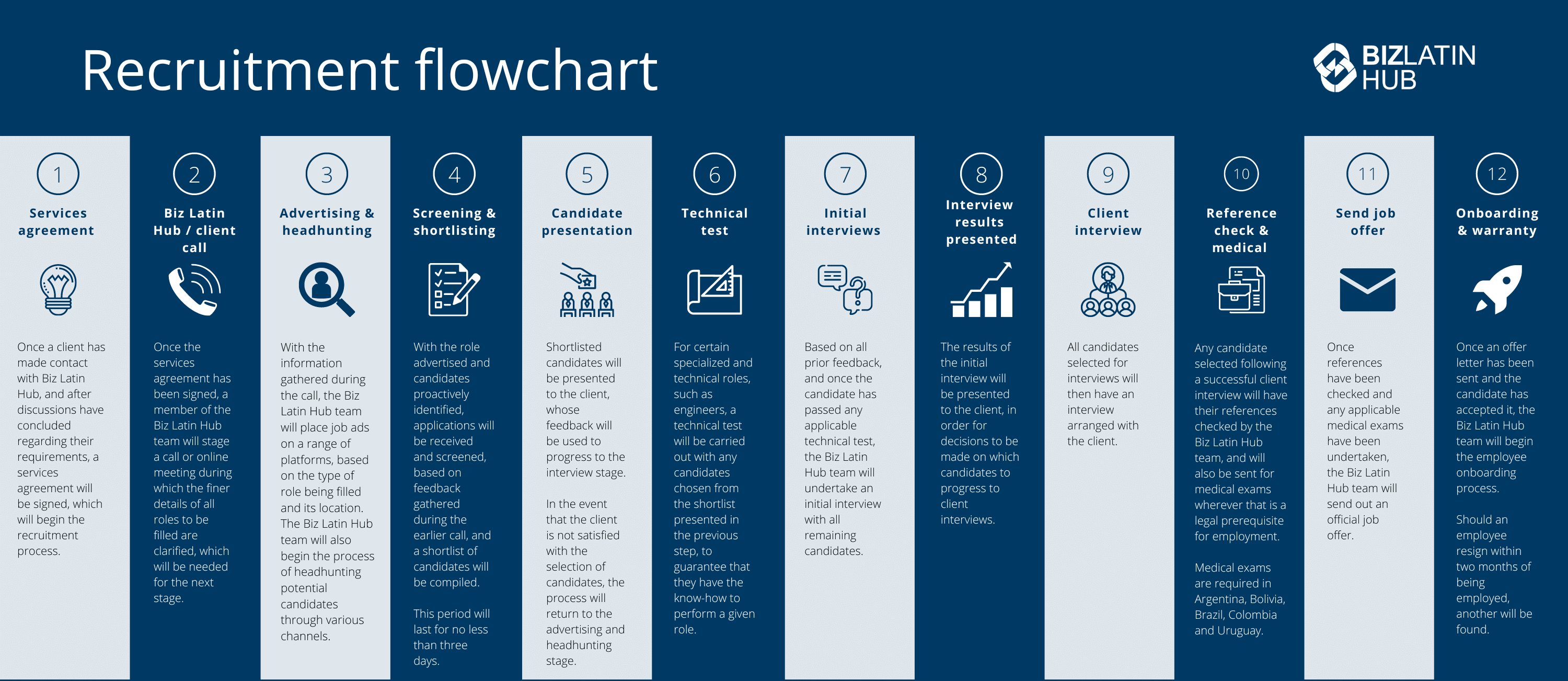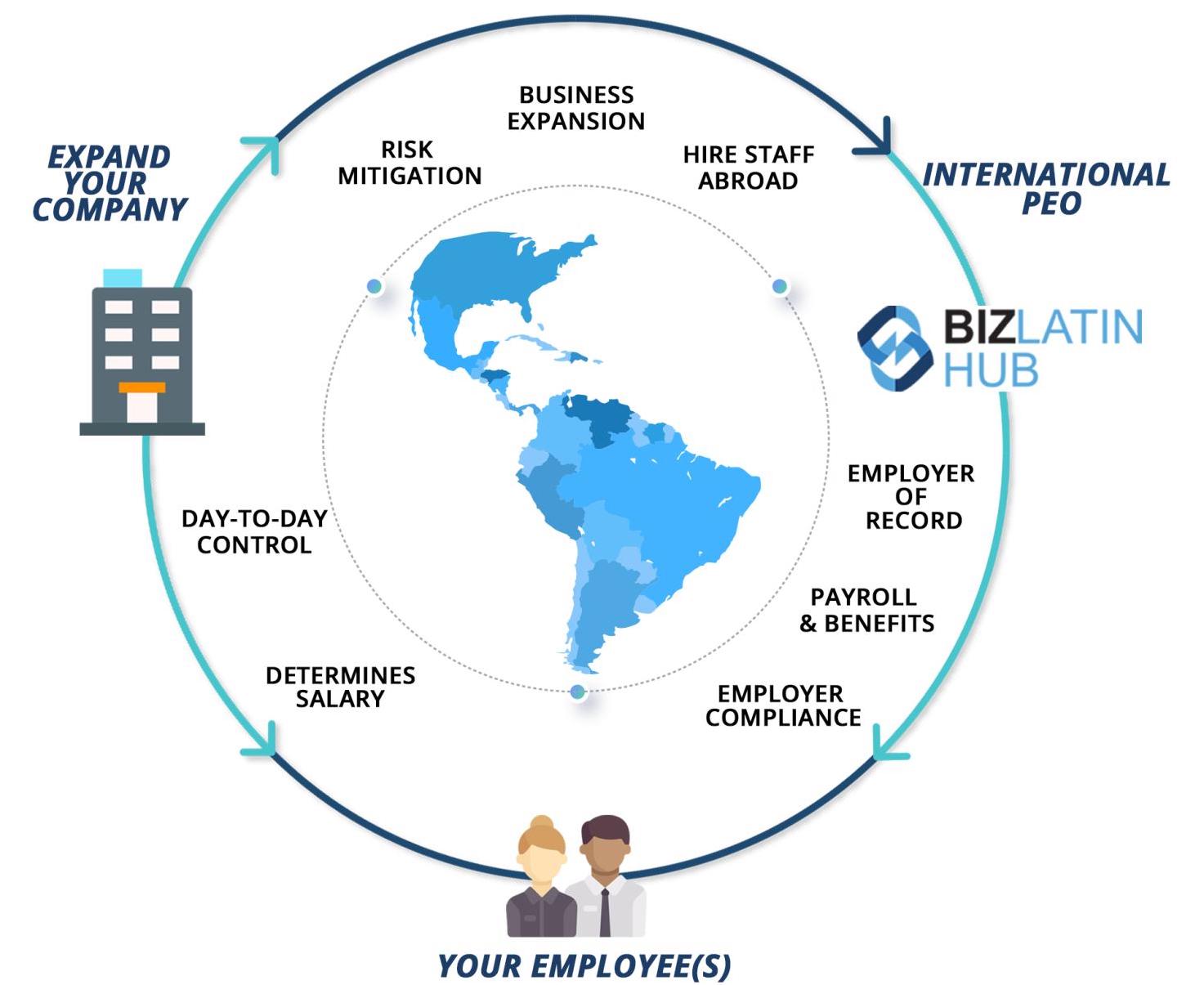How can our Hiring & International PEO Services help your Business in Latin America and the Caribbean?
Our Hiring & International PEO Services
Learn more about our hiring, headhunting, executive recruitment and international PEO services and how we can help you navigate the legal complexities of local markets in Latin America and the Caribbean when hiring staff for your business expansion.
Headhunting / Executive Recruitment
Employee Onboarding
Employment Law
Professional Employer Organization (PEO)
Employer of Record (EOR)
We are specialists in headhunting / recruitment services for the following sectors:
IT / Tech Hiring:
Non-Government Organizations (NGOs) Recruitment
Executive or Senior Executive Recruitment

How much does an employee cost in Latin America?
It’s not always easy for foreign executives to calculate the cost of hiring an employee when expanding into Latin America. As an employer in a new market, it’s challenging to know and comply with all employment law regulations, including paying employee benefits.
Use our Payroll Calculator – also known as an employee cost calculator – to find out the cost of hiring an employee in Latin America. This tool shows you how to calculate workers’ compensation cost per employee. Labor laws in Latin America can differ across countries; we make it easy to find out the cost of hiring an employee in your chosen market.
Once you know how much it costs to hire your employee, engage with a trusted Professional Employer Organization – PEO in Latin America to support your hiring needs.
Payroll Calculator
Use the BLH payroll calculator to calculate the cost of an employee in Latin America.
Find out the employee cost for the salary you have set, including the cost of employee benefits relevant to your country.
01. Enter the country you want to calculate employee cost for
02. Enter the currency you’re using
03. Enter the salary amount you plan to pay your employee
03. Click on the “Calculate” button
|
What are your options when hiring new employees?
Hire Through a Local Legal Entity
We offer a tailored solution for setting up your local legal entity. Once this legal entity is setup, you will have full power to hire, employ and manage local staff.
Hire Through a PEO solution
For those companies who do not wish to setup and maintain a local entity, we offer a PEO solution which allows you to hire local staff without the administrative and HR burden.
What is an international PEO?
An international PEO or Professional Employer Organization is a global employment solution that enables companies to hire employees fast, efficiently and without the requirement to establish a local legal entity.
Whereby, Biz Latin Hub will contract the employees on your behalf, and will become their legal Employer of Record, allowing you to focus on managing and growing your business.

Are you ready to start hiring new employees for your business expansion?
Frequently Asked Questions on Hiring Employees in Latin America
Based on our experience, these are the most commonly questions about Hiring employees an international Professional Employer Organization (PEO) and how Biz Latin Hub can help.
Headhunting, also known as executive recruitment, is a proactive approach to finding talent in the job market. A headhunter or executive recruiter actively searches for individuals who have the specific skills and qualifications to meet a client’s needs.
Headhunting is a specialized form of recruitment that is proactive and often used for executive positions. In contrast, standard recruitment services are more routine and passive, focusing on filling vacancies as they arise.
A Professional Employer Organization (PEO) is a service provider that allows businesses to hire employees in foreign countries without the need to establish a legal entity in that country. Acting as the ‘Employer of Record’ (EOR), a PEO handles all legal and regulatory requirements, freeing up your business to focus on its core operations.
The terms Employer of Record (EOR) and Professional Employer Organization (PEO) are often used interchangeably. They both refer to a service that includes recruitment and payroll outsourcing.
Professional Employer Organizations (PEOs) are a good fit for companies that wish to hire staff to support their commercial activities in a territory where they don’t have a legal presence. This could be a temporary arrangement while the business is undergoing local incorporation, or a long-term strategy to avoid establishing a legal entity. It’s particularly useful for companies looking to hire a small number of specialist staff, or staff for roles such as sales or representation.
The main advantage of using an Employer of Record (EOR) is the speed at which you can start working. An EOR allows you to hire staff quickly without having to establish a legal entity, meaning you can start operations as soon as you find the right personnel.
When you hire through a Professional Employer Organization (PEO), the PEO employs your chosen candidate through their local legal entity. They then process the worker’s payment on your behalf, reducing your need to engage in that territory. Your involvement is essentially limited to instructing the PEO when to hire or terminate employees.
Absolutely. Our experienced recruiters, based across Latin America, have successfully helped many clients find their ideal staff. Typically, it takes between two to four weeks to find a candidate with a specialized profile.
We generally expect to hire your candidate within a week of being assigned as your Professional Employer Organization, for entry-level positions.
For Employer of Record (EOR) services, we charge a simple monthly service fee per employee, in addition to reimbursement of the total cost of the employee.
While the client is responsible for providing the funds to cover payroll, employment-related benefits, and payroll taxes in full, as your PEO firm, we handle the administration of wage payments to employees, as well as the payment of employment-related benefits and applicable taxes.
While the ultimate responsibility for the employees lies with the client, we provide comprehensive guidance regarding employment laws and regulations as part of our PEO / EOR service package.
To begin utilizing our Professional Employer Organization services and streamline your international hiring process, please get in touch with us through our contact us page. Our team of experts is ready to assist you with all your hiring needs.
PEO setup typically takes 1-4 weeks, while legal entity formation requires 3-6 months in most Latin American countries. PEO services accelerate market entry by eliminating the need for complex local incorporation procedures.
PEO arrangements may limit participation in government tenders and public contracts because the company lacks direct legal presence in the country. Government and institutional bidding often requires local incorporation as a prerequisite for participation.
Employee termination under PEO follows strict local labor laws. The PEO handles compliance, paperwork, and mandatory severance calculations. Companies must adhere to notice periods and termination procedures specific to each Latin American country while working through their PEO provider.
What our clients say
As a foreigner in Colombia with a new startup business, local support regarding legal compliance, employee hiring and accounting/taxation requirements has been invaluable to our success in the region.
– Dan Hill, Founder of Golden Lion Cider
What Clients Say About Our Hiring and PEO Services
WHAT MAKES BIZ LATIN HUB DIFFERENT?
Your Local Partner
We can provide you the complete, fully-integrated and tailored back office, PEO and entity incorporation solution
Your Need is Our Focus
We know one size doesn’t fit all – we will work with you to understand your business needs and to provide a personalized market entry and back office solution
Globally Minded & Local Expertise
Trust our local team of lawyers and accountants to establish your business, form your legal entity, hiring employees and legal entity compliance
Communication at its Best
English, Spanish or Portuguese – Our local and expatriate team of accountants and lawyers can support you in multiple languages
